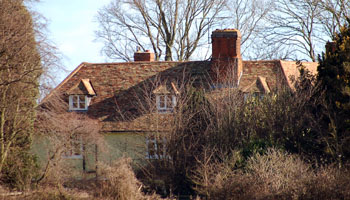Old Warden Manor After The Reformation
Old Warden Manor
The manor of Wardon was held by Wardon Abbey until the monastery was dissolved in 1537. The manor was attached to the Honour of Ampthill in 1542 and granted in 1550 to Princes Elizabeth, later Elizabeth I. In 1611 Prince Henry of Wales had the manor and, on his death it passed to his brother Charles, later Charles I.
In 1616 the manor was leased by Charles to Francis Bacon for 99 years and in 1628 the reversion of this lease was granted to trustees for the Corporation of London. Some time between 1699 and 1714 the manor was purchased by Sir William Palmer and his son Charles sold it in 1773 to Samuel Whitbread and the Whitbread family continued and Lords of the Manor until successive acts in the 1920s rendered the title meaningless in all but name.
Hill Manor
This manor was created after the dissolution of Warden Abbey, being in John Harding's hands at his death in 1550. Hill was a hamlet in Old Warden just north of Broom. Harding's heir was his daughter Cecilia. A Cecilia, wife of George Mordaunt held the manor in 1585 though her precise relationship with the earlier Cecilia is not known. At about this date the Mordaunts conveyed the manor to Lord Lewis Mordaunt and his son Henry, who sold it in 1604 to Sir William Palmer, High Sheriff of Bedfordshire who still owned it at his death in 1626. In 1642 the manor was part of a settlement on the marriage of William Palmer and Margaret Gardiner. Interestingly, given the future history of the manor, in 1685 it was conveyed by William Palmer to trustees as part of a mariage settlement, one of whom was Thomas Halfpenny of Lilley [Hertfordshire].
By 1729 the manor belonged to Mary Mackdowall, mother of Thomas Palmer, who had died without heirs that year and she conveyed it to trustees as part of a marriage settlement between her nephew Thomas Halfpenny and Lettice Drage [W2382-2383]. On Mary's death in 1735 the house passed to Halfpenny [W2384]. A document of 1766 [AD2974] has both the Manor and Hill House being put up for sale by Halfpenny. However, he did not sell as his son Bernard conveued it to Bedford lawyer Jeremy Fish Palmer in 1772.
In 1799, after Fish Palmer's death, his executor and brother sold both Hill Manor and Hill House to Samuel Whitbread MP of Southill for £6,100. Samuel Whitbread seems to have sold both the manor of Hill and Hill House to the Second Baron Ongley in 1800. The manor is last mentioned as owned by the 3rd Baron Ongley in 1837.

The Hill House March 2008
It seems likely that the current The Hill House is the manor house - it was listed by the former Department of Environment in 1972 who reckoned it to be a 17th century house which had been reworked in the 18th and 19th centuries, which suggests that it was originally built by the Palmers, though whether or not on the site of an earlier building is not known. Most of the exterior of the house is colour-washed rough-cast over a timber frame, although the ground floor and north gable end were rebuilt in 18th century brick. The house is in a U-plan of two storeys with attics, the main entrance being in the east elevation of the central block.